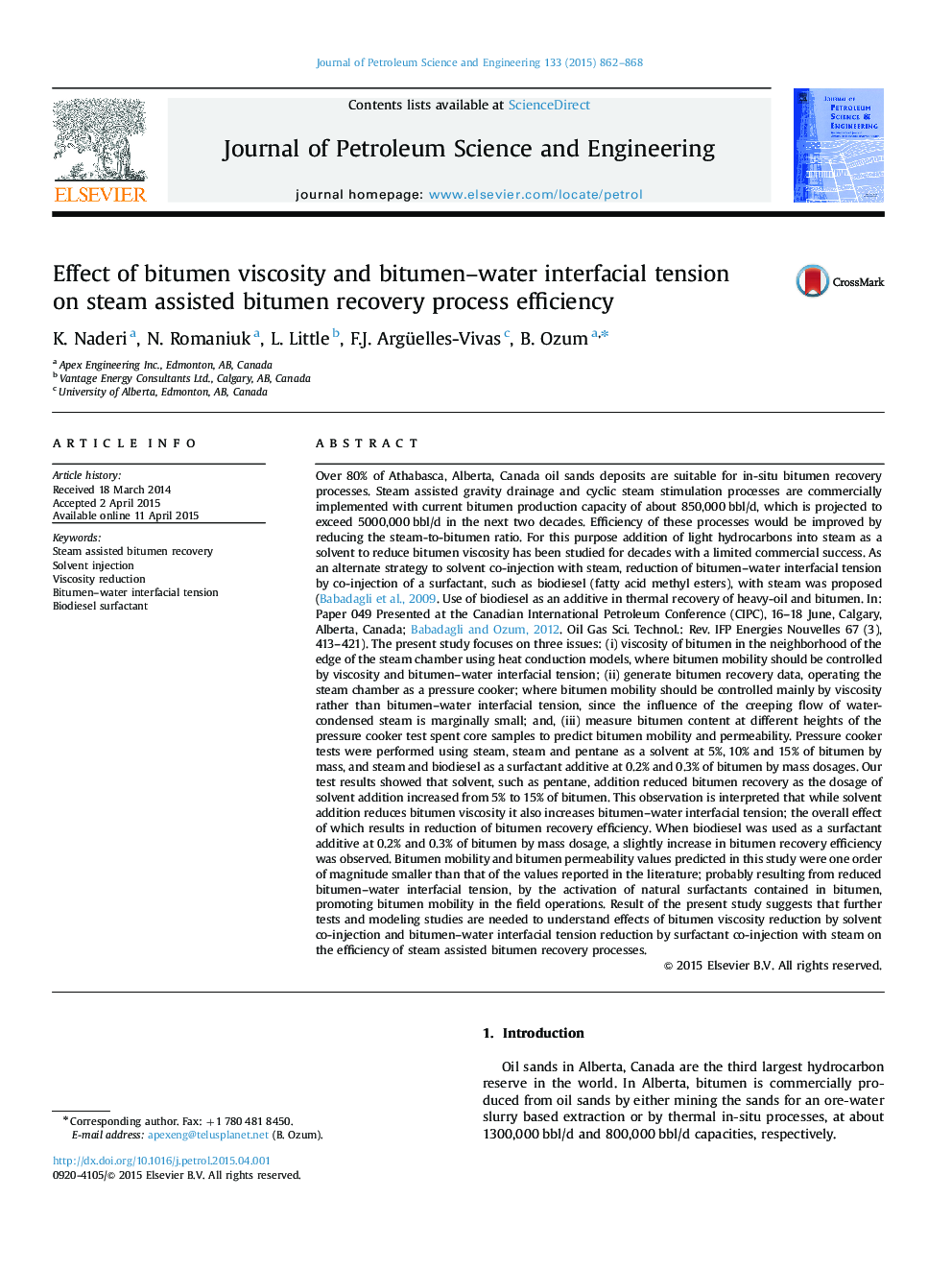| کد مقاله | کد نشریه | سال انتشار | مقاله انگلیسی | نسخه تمام متن |
|---|---|---|---|---|
| 1754775 | 1522808 | 2015 | 7 صفحه PDF | دانلود رایگان |
• Biodiesel, surfactant additive to increase steam assisted bitumen recovery process efficiency.
• Bitumen and a large volume of water flows as two immiscible fluids at the edge of steam chamber.
• Solvent and surfactant co-injection with steam on bitumen recovery efficiency were tested.
• Solvent use reduces bitumen viscosity; however, increases bitumen–water interfacial tension.
• Attention must be focused on the role of bitumen–water interfacial tension on bitumen recovery.
Over 80% of Athabasca, Alberta, Canada oil sands deposits are suitable for in-situ bitumen recovery processes. Steam assisted gravity drainage and cyclic steam stimulation processes are commercially implemented with current bitumen production capacity of about 850,000 bbl/d, which is projected to exceed 5000,000 bbl/d in the next two decades. Efficiency of these processes would be improved by reducing the steam-to-bitumen ratio. For this purpose addition of light hydrocarbons into steam as a solvent to reduce bitumen viscosity has been studied for decades with a limited commercial success. As an alternate strategy to solvent co-injection with steam, reduction of bitumen–water interfacial tension by co-injection of a surfactant, such as biodiesel (fatty acid methyl esters), with steam was proposed (Babadagli et al., 2009. Use of biodiesel as an additive in thermal recovery of heavy-oil and bitumen. In: Paper 049 Presented at the Canadian International Petroleum Conference (CIPC), 16–18 June, Calgary, Alberta, Canada; Babadagli and Ozum, 2012. Oil Gas Sci. Technol.: Rev. IFP Energies Nouvelles 67 (3), 413–421). The present study focuses on three issues: (i) viscosity of bitumen in the neighborhood of the edge of the steam chamber using heat conduction models, where bitumen mobility should be controlled by viscosity and bitumen–water interfacial tension; (ii) generate bitumen recovery data, operating the steam chamber as a pressure cooker; where bitumen mobility should be controlled mainly by viscosity rather than bitumen–water interfacial tension, since the influence of the creeping flow of water-condensed steam is marginally small; and, (iii) measure bitumen content at different heights of the pressure cooker test spent core samples to predict bitumen mobility and permeability. Pressure cooker tests were performed using steam, steam and pentane as a solvent at 5%, 10% and 15% of bitumen by mass, and steam and biodiesel as a surfactant additive at 0.2% and 0.3% of bitumen by mass dosages. Our test results showed that solvent, such as pentane, addition reduced bitumen recovery as the dosage of solvent addition increased from 5% to 15% of bitumen. This observation is interpreted that while solvent addition reduces bitumen viscosity it also increases bitumen–water interfacial tension; the overall effect of which results in reduction of bitumen recovery efficiency. When biodiesel was used as a surfactant additive at 0.2% and 0.3% of bitumen by mass dosage, a slightly increase in bitumen recovery efficiency was observed. Bitumen mobility and bitumen permeability values predicted in this study were one order of magnitude smaller than that of the values reported in the literature; probably resulting from reduced bitumen–water interfacial tension, by the activation of natural surfactants contained in bitumen, promoting bitumen mobility in the field operations. Result of the present study suggests that further tests and modeling studies are needed to understand effects of bitumen viscosity reduction by solvent co-injection and bitumen–water interfacial tension reduction by surfactant co-injection with steam on the efficiency of steam assisted bitumen recovery processes.
Journal: Journal of Petroleum Science and Engineering - Volume 133, September 2015, Pages 862–868
